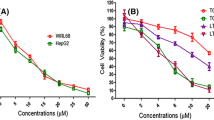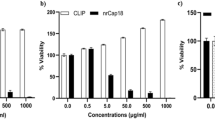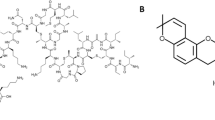Abstract
Purpose
Although antimicrobial peptides (AMPs) were initially known as compounds of the innate immune system to fight microbial pathogens, it has been recently proposed that differences in normal and cancer cell membranes cause the anticancer effect of these peptides. The aim of this study was to evaluate the anticancer effect of MELITININ+BMAP27-conjugated peptide against colorectal cancer (CRC) cells.
Methods
The MELITININ+BMAP27-conjugated peptides were designed and the β-naphthylalanine residues were added to the termini to improve the anticancer effect. CRC cancer cell lines including HT29, SW742, HCT-116, and WiDr were used. After preparing concentrations of 5, 10, 25, 50, 100, 150, 200, and 400 μg/mL of peptide solution, the rate of cell death after 12, 24, and 48 h was assessed using MTT test. After confirmation of the 30 µg/mL efficacy and nontoxic concentration, the cells were exposed to this concentration, and the total RNA was extracted. The quantitative real-time PCR (RT-qPCR) technique was performed for the amplification of Bax, caspase3, atg5, and GAPDH (glyceraldehyde 3-phosphate dehydrogenase as the internal control) genes.
Results
The cytotoxicity of peptide against normal cells exhibited that the IC50 at 24 and 4 h included 80 and 100 µg/mL, respectively. After 24–72 h of treatment, a significant difference in the mean percentage of CRC living cells was observed at concentrations of 50–400 μg/mL of conjugated peptide (p < 0.05). The IC50 of the peptide at 24, 48, and 72 h of exposure was measured as 30, 20, and 10 μg/mL, respectively. The peptide resulted in a significant increase of 2.35-fold in the mean expression of Bax gene in CRC cells (p < 0.001). It also caused a significant increase of 1.75 times (p = 0.0112) of caspase 3 gene and 1.2 times (p = 0.0217) of atg5 gene. There was no significant difference among cell lines regarding the expression of each gene.
Conclusion
The conjugated peptide caused the death of CRC lines via induction of the apoptosis and necrosis mechanisms. More studies are needed in this regard.







Similar content being viewed by others
Availability of Data and Materials
All the data generated or analyzed during this study are included in this published article (and its supplementary information files).
References
Okamoto R, Gery S, Kuwayama Y, Borregaard N, Ho Q, Alvarez R, Akagi T, Liu GY, Uskokovic MR, Koeffler HP. Novel Gemini vitamin D3 analogs: large structure/function analysis and ability to induce antimicrobial peptide. Int J Cancer. 2014;134(1):207–17.
Torrisi M, Pollastri G, Le Q. Deep learning methods in protein structure prediction. Comput Struct Biotechnol J. 2020;18:1301–10.
Liu X, Li Y, Li Z, Lan X, Leung PH, Li J, Yang M, Ko F, Qin L. Mechanism of anticancer effects of antimicrobial peptides. Journal of Fiber Bioengineering and Informatics. 2015;8(1):25–36.
Hoskin DW, Ramamoorthy A. Studies on anticancer activities of antimicrobial peptides. Biochimica et Biophysica Acta (BBA)-Biomembranes. 2008;1778(2):357–75.
Yu G, Baeder DY, Regoes RR, Rolff J. Combination effects of antimicrobial peptides. Antimicrob Agents Chemother. 2016;60(3):1717–24.
Chu HL, Yip BS, Chen KH, Yu HY, Chih YH, Cheng HT, Chou YT, Cheng JW. Novel antimicrobial peptides with high anticancer activity and selectivity. PLoS One. 2015;10(5):e0126390.
Zandsalimi F, Talaei S, Noormohammad Ahari M, Aghamiri S, Raee P, Roshanzamiri S, Yarian F, Bandehpour M, Zohrab ZZ. Antimicrobial peptides: a promising strategy for lung cancer drug discovery? Expert Opin Drug Discov. 2020;15(11):1343–54.
Tornesello AL, Borrelli A, Buonaguro L, Buonaguro FM, Tornesello ML. Antimicrobial peptides as anticancer agents: functional properties and biological activities. Molecules. 2020;25(12):2850.
Leite ML, da Cunha NB, Costa FF. Antimicrobial peptides, nanotechnology, and natural metabolites as novel approaches for cancer treatment. Pharmacol Ther. 2018;1(183):160–76.
Joseph L, Srinivasan K. Triacontanoic ester of 5ʹʹ-hydroxyjustisolin: Tumour suppressive role in cervical cancer via Bcl-2, BAX and caspase-3 mediated signalling. Toxicol Rep. 2019;6:1198–205.
Yue Y, Lv W, Zhang L, Kang W. MiR-147b influences vascular smooth muscle cell proliferation and migration via targeting YY1 and modulating Wnt/β-catenin activities. Acta Biochim Biophys Sin. 2018;50:905–13.
Hamdan NT, Jwad BAAAA, Jasim SA. Synergistic anticancer effects of phycocyanin and Citrullus colocynthis extract against WiDr, HCT-15 and HCT-116 colon cancer cell lines. Gene Rep. 2021;22:100972.
Baxter AA, Lay FT, Poon IK, Kvansakul M, Hulett MD. Tumor cell membrane-targeting cationic antimicrobial peptides: novel insights into mechanisms of action and therapeutic prospects. Cell Mol Life Sci. 2017;74(20):3809–25.
Moore KS, Bevins CL, Brasseur MM, Tomassini N, Turner K, Eck H, Zasloff M. Antimicrobial peptides in the stomach of Xenopus laevis. J Biol Chem. 1991;266:19851–7.
Hilchie AL, Hoskin DW, Coombs MP. Anticancer activities of natural and synthetic peptides. Antimicrob Peptides. 2019:131–47.
Emelianova AA, Kuzmin DV, Panteleev PV, Sorokin M, Buzdin AA, Ovchinnikova TV. Anticancer activity of the goat antimicrobial peptide ChMAP-28. Front Pharmacol. 2018;21(9):1501.
Wang C, Dong S, Zhang L, Zhao Y, Huang L, Gong X, Wang H, Shang D. Cell surface binding, uptaking and anticancer activity of L-K6, a lysine/leucine-rich peptide, on human breast cancer MCF-7 cells. Sci Rep. 2017;7(1):1–3.
Pedron CN, Andrade GP, Sato RH, Torres MD, Cerchiaro G, Ribeiro AO, Oliveira VX Jr. Anticancer activity of VmCT1 analogs against MCF-7 cells. Chem Biol Drug Des. 2018;91(2):588–96.
Deslouches B, Di YP. Antimicrobial peptides with selective antitumor mechanisms: prospect for anticancer applications. Oncotarget. 2017;8(28):46635.
Araki M, Kurihara M, Kinoshita S, Awane R, Sato T, Ohkawa Y, Inoue YH. Anti-tumour effects of antimicrobial peptides, components of the innate immune system, against haematopoietic tumours in Drosophila mxc mutants. Dis Models Mech. 2019;12(6):dmm037721.
Acknowledgements
This study was performed by the authors.
Funding
This study was supported by Al-Maarif University College, Iraq.
Author information
Authors and Affiliations
Contributions
All the authors have participated equally.
Corresponding author
Ethics declarations
Ethics Approval and Consent to Participate
This study was approved by the ethics committee of Al-maarif University. All the authors had the written consent to participate (those subjects without the consent had been excluded from the study).
Consent for Publication
All the authors have the consent of publication. Moreover, the patients have the consent of participation and publication.
Competing Interests
The authors declare no competing interests.
Additional information
Publisher's Note
Springer Nature remains neutral with regard to jurisdictional claims in published maps and institutional affiliations.
Rights and permissions
About this article
Cite this article
Saleh, R.O., Essia, I.N.A. & Jasim, S.A. The Anticancer Effect of a Conjugated Antimicrobial Peptide Against Colorectal Cancer (CRC) Cells. J Gastrointest Canc 54, 165–170 (2023). https://doi.org/10.1007/s12029-021-00799-4
Accepted:
Published:
Issue Date:
DOI: https://doi.org/10.1007/s12029-021-00799-4




